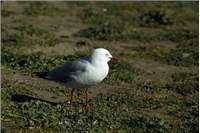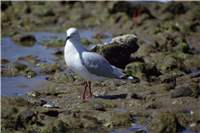Family
Laridae
Genus
Larus
Species
novaellandiae
Threats/Control Methods - Regional
The number of Silver Gulls has risen greatly with the availability of human scrap foods. Their population growth is controlled only by the lack of available nesting sites.
Threats/Control Methods - Local
Free roaming domestic pets may predate the Silver Gulls while roosting on lawns in the evenings.
Local/Urban Actions
Hand feeding scraps to Silver Gulls is not a good idea, as it makes them more determined to steal food and annoy people.
Common Names
Silver Gull, Red-billed Gull, Red-legged Gull, Seagull
Distinguishing Features
This well-known bird is medium-sized at 38-42cm. It has silky-white plumage over its head, neck, tail and underparts. Its wings are light grey with black and white tips. Its bright red bill, eye ring and legs stand out from the light-coloured feathers. Young birds have mottled brown appearance, with brown legs and bill.
Survey Techniques
Call and visual identification.
Species Call
A variety of social calls, 'karrgh-karrgh-karrgh', a deep 'korrr' or a high 'kwee-arrgh'.
Similar Species
No other species has the bright red bill and legs of the Silver Gull.
Distribution
This species is found across all of Australia, especially along the coastal regions and islands. In Canberra, huge flocks roost on the lawns on the south end of Commonwealth Avenue Bridge. They breed in the southern regions of Australia and are also found in New Zealand and New Caledonia.
Country of Origin
Australia
Conservation (Pet/Pest) Status - Regional
Large populations inhabit the areas around Lakes Burley Griffin and Ginninderra. Numbers are highest in the winter months.
Conservation (Pet/Pest) Status - National
Secure, not listed under the EPBC Act 1999. They are considered the best-known seabirds in Australia and have benefited from the spread of humans across the country.
LSCCES Population
Many birds were sighted at the NMA and Civic West, with a few seen on the ANU campus.
Associated vegetation community
This species will inhabit any area, as they are very adaptable and will eat and drink anything they can find. They are most common along coastal beaches and cliffs, coastal towns, offshore islands and inland rivers, lakes, farmlands and rubbish dumps.
Limiting Resources
Silver Gulls are dependant on the avialability of either fresh or salty water. They have adapted to diet of any food, however they are limited by space for nesting sites.
Breeding
They usually start to breed at three years of age. In the NSW region of Australia, the breeding season runs from September until January. However along the east coast there are so many gulls that nest site availability is limited and the breeding season is extended to share the space. They breed in large colonies on offshore islands, usually just scraping a shallow dip into the sand and lining it with a little vegetation. It will also nest in low, dense shrubbery or on logs if no bare ground is available. The 2-4 eggs are blotched with olive, black and brown. The parents share incubation for 22-26 days and the hatched young leave the nest after about four weeks and by 6 weeks they are fully independent.
Behaviour
These birds are noisy and bold, happily scavenging around humans for any food they can get. They are highly social and spend time in large groups. At dawn and dusk they are likely to be flying about in flocks, taking insects. Hundreds of birds can be seen flying high over the northern suburbs within close range of a lake.
Functional Group
Food Species
There diet varies with location and availability. They feed on plankton, seaweed and crustaceans along the coast, insects and their larvae on farmlands, rubbish around urban bins or any food from the picnic rugs of people enjoying a day at the beach or the park.
Predators
If young birds wander from the nest prematurely they are likely to be killed by other adult Silver Gulls. Their ground lying nests are likely to be predated by numerous species, including European Red Foxes (Vulpes vulpes), Dogs (Canis familiaris), Cats (Felis catus), Water Rats (Hydromys chrysogaster), Purple Swamphens (Porphyrio porphyrio ) and Swamp Harriers (Circus aeruginosus). Adult Silver Gulls are known to attack the young of many other bird species.
Interesting Fact
Silver Gulls establish a hierarchy of dominance, with older birds attempting to drive out younger birds from feeding territories.
References - (reader suitability of references, P=Primary teachers, S=Secondary students, T=Tertiary students and researchers)
Books:Morcombe, M. 2000. Field Guide to Australian Birds. Steve Parish Publishing. Archerfield. Australia P, S, T
Schodde, R. and Tideman, S. (eds) 1990. Reader's Digest Complete Book of Australian Birds (2nd Edition). Reader's Digest Services Pty Ltd. Sydney. P, S, T
Taylor, M. and Day, N. 1993. Field Guide to the Birds of the ACT. National Park Association of the ACT Inc. Canberra. P, S, T
Internet: Birds in Backyards. 2006. [online]. Available at:http://www.birdsinbackyards.net P, S, T
Online Publications:ACT Government. 2006. Information Sheet: Stormwater Pollution from Residential Areas. Environment ACT. [online]. Available at: http://www.environment.act.gov.au/__data/assets/pdf_file/13168/Stormwater_Pollution_from_Residential_Areas.pdf P, S, T
Nix, H. and Cunningham, R. 2006. Birds of the Lower Sullivans Creek Catchment, Canberra ACT. Prepared for the Life in the Suburbs project using data from the Lower Sullivans Creek Catchment Ecological Survey (LSCCES). Australian National University. Canberra. [online]. Available at: http://www.lifeinthesuburbs.com.au/category.php?id=65 S, T
Queanbeyan City Council. 2004. Study on the Current State of Jerrabomberra Creek . Maunsell Australia Pty Ltd. Canberra. [online]. Available at: http://www.qcc.nsw.gov.au/Documents/YRJTKVCEDKP.pdf S, T
Olsen, P. and Weston, M. 2004. The State of Australian Birds 2004: Water Wetlands and Birds. Birds Australia. [online] Available at: http://www.environment.gov.au/biodiversity/publications/birds-04/regional.html S, T


 Top
Top Top
Top